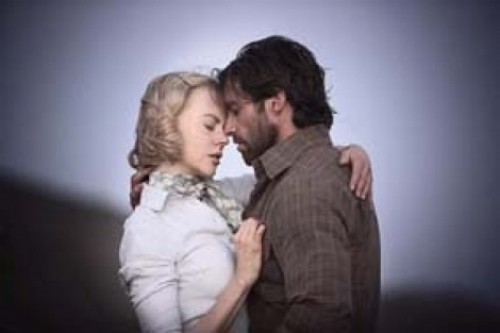Cinema | Op-erratic: One epic-scale story isn’t enough for Baz Luhrmann’s Australia.
By Scott Renshaw @scottrenshawBecause he’s working as an artist in the 21st century, Baz Luhrmann makes movies. But let there be no doubt: If not for this fluke of history, he’d be creating operas.
nOr maybe it’s more accurate to say that creating operas is what he does anyway—he just happens to be recording them on film. In William Shakespeare’s Romeo + Juliet and Moulin Rouge!, Luhrmann employed a grand sort of cinematic theatricality, using big stories to capture big emotions. Subtle thematic undercurrents aren’t really his milieu; this is a man who wants to convey romance with fireworks and Elton John ballads.
nIf you’ve seen Luhrmann’s films, Australia is exactly the kind of story you’d expect from him, painted on a canvas the size of a continent. Or more specifically, it’s two of the kind of stories you’d expect from him. For the first 85 minutes, it’s a sprawling Western set in 1939 Northern Australia, where English noblewoman Lady Sarah Ashley (Nicole Kidman) is pushing for her husband to sell a failing cattle ranch. But Lord Ashley is dead before Sarah even arrives from England, perhaps the victim of a power play by local cattle baron “King” Carney (Bryan Brown). Unwilling to surrender to Carney’s thuggery, Sarah hires an itinerant cowboy known as The Drover (Hugh Jackman) to help lead the herd to the port town of Darwin, where a contract to supply beef to the English war effort could save the ranch.
nThus begins an old-fashioned white-hats-vs.-black-hats brand of melodrama, as Sarah, Drover and their makeshift crew try to survive the machinations of Carney and his henchman Fletcher (David Wenham) to maintain their monopoly. And on that level—grand music, panoramic cinematography, a little lovin’ around the campfire—it genuinely works. You do have to make it through Kidman’s early squeal-filled performance—for some reason, working with Luhrmann brings out the cartoon character in her—but eventually Luhrmann settles into a satisfying throwback rhythm mixed with his own brand of magical realism. It’s not every filmmaker who could give a standard-issue stampede sequence a mysticism to match its sheer ferocity.
nThere is, however, another 70 minutes still to go by the time Sarah and Drover finish their drive, which launches the second half of Luhrmann’s double-feature. Carney—a promising villain—abruptly disappears from the narrative entirely; now, it’s time for an epic wartime romance, combined with the dark chapter in Australia’s history in which mixed-race children were isolated from their Aboriginal families. Not only are Sarah and Drover separated as the action moves through 1941, but Sarah is separated from Nullah (Brandon Walters), the “half-caste” boy to whom she has become a surrogate mother. Luhrmann desperately wants this tale of mother-child division to pack as much of an emotional wallop as the love affair between Sarah and Drover, but by splitting his attention between pure romance and a political point, he ends up short-changing both plotlines. And while Jackman nails the thawing of Drover’s broken heart, it doesn’t help that Kidman never seems to get a handle on the kind of woman Sarah is supposed to have been, or is supposed to be evolving into.
nThe third act also gives Luhrmann an excuse to work on the largest possible scale as he re-creates the Japanese air attack on Darwin. Indeed, it’s an impressive pyrotechnic display, providing the backdrop for his three principal characters not knowing which among the others is alive or dead (as well as an excuse for a few more wide-angle “check out the size of the universe under my control” shots). It’s also something of a trap for the filmmaker. Luhrmann’s expansive vision works when it’s connected directly to love, and for too long at the end of Australia, he’s just pushing down the plungers for the explosives.
nFor all that, Australia still hits some of those unmistakable Luhrmann notes that only he could pull off. Nullah’s infatuation with The Wizard of Oz and its theme of returning home becomes a through-line that somehow makes “Over the Rainbow” feel plaintive rather than campy. Opera may be grandiose, but at its core, it’s also uncomplicated, driven by fundamental themes of love and betrayal and redemption. Australia finds Luhrmann over-reaching, stapling two movies together and trying to wrap his arms around too big an aria.
n nAUSTRALIA
n
nNicole Kidman, Hugh Jackman, Brandon Walters
nRated PG-13
More by Scott Renshaw
-
Film Reviews: New Releases for April 19
The Ministry of Ungentlemanly Warfare, Abigail, The Beast, Hard Miles, Sasquatch Sunset and more
- Apr 19, 2024
-
Faces of Salt Lake County book and portrait reception
Images and personal stories in a new book reveal local demographic diversity
- Apr 17, 2024
-
Feature film review: THE BEAST
A filmmaker's compelling ideas get a bit tangled in references to his creative influences.
- Apr 17, 2024
- More »





